We studied the traffic of 3,000 websites to better understand the size and make-up of AI traffic—including how much of it is being sent, the most common referral sources, and how that differs depending on the size of the site.
We analyzed the traffic differences between sites driving greater than 10,000 visitors, between 1,000 and 9,999 visitors, and below 999 visitors per month, across the following seven AI chatbots: ChatGPT, Claude, Copilot, Gemini, Perplexity, Jasper, and Mistral.
Here are our top findings:
- 63% of sites receive AI traffic overall
- 98% of AI traffic is sent by three chatbots
- ChatGPT is the biggest referrer, accounting for 50% of AI traffic
- 0.17% of the average website’s traffic comes from AI chatbots
- The smallest websites get the greatest % of total traffic from AI
Thanks to our data scientist Xibeijia Guan for aggregating all of the data behind this study.
We analyzed total traffic data from an anonymized sample of 3,000 sites.
Across the total sample, 1,900 sites received at least one visit from an AI source.
Looking at it another way, 63% of the sites in our study had at least one visitor arrive via an AI chatbot.
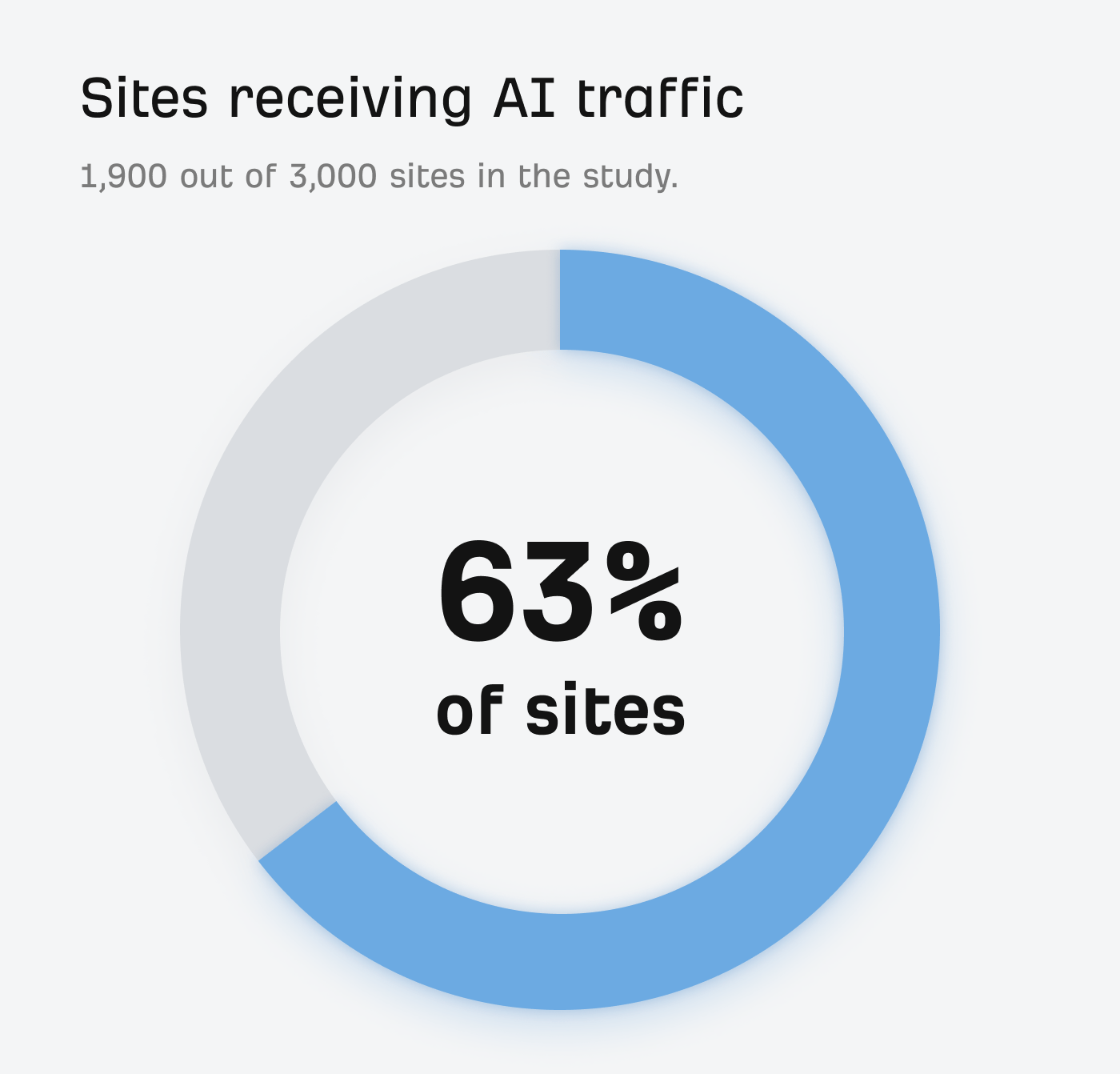
According to the data we can accurately attribute, you have roughly a 2 in 3 chance of receiving a site visit via AI.
This data relies on the referral source being trackable in analytics, but it’s important to note that some AI traffic will pull through as “direct”.
In other words, this data represents just the visible AI traffic—the minimum amount of AI visitors a website receives.
While there’s surely more to the story, you can still learn a lot about your AI visibility from the data you can track.
Monitoring your AI traffic can show you which sources send users your way, which pages on your site act as AI traffic magnets, and how that traffic is changing or growing over time.
Knowing this, you can optimize your AI referral pages and paths, separating pages that drive vanity traffic from those that actually engage or convert.
In my article on LLM optimization, I discovered a few techniques that can help you work your brand into AI answers.
But, I’d also recommend reading the following posts:
Analyze your own AI traffic with Ahrefs Web Analytics
You can see your own referral traffic from AI in Ahrefs Web Analytics when you link up your site via a snippet of Javascript.
Once that’s done, follow these steps:
- Head to “Dashboard”
- Click on “Projects”
- Select the “Web Analytics” tab
- Click on your project
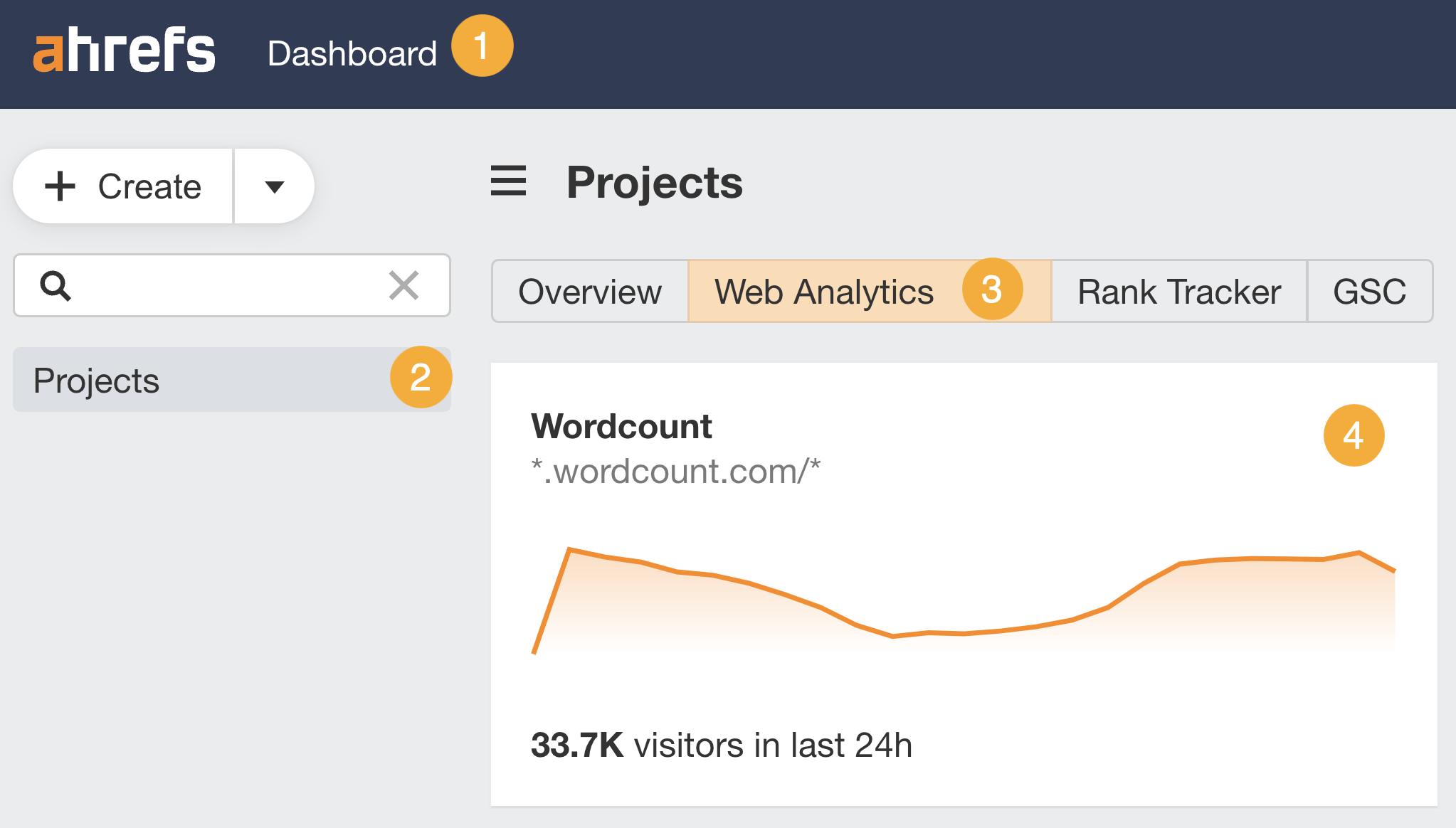
Then, add a “channel” filter to see a breakdown of your LLM traffic.
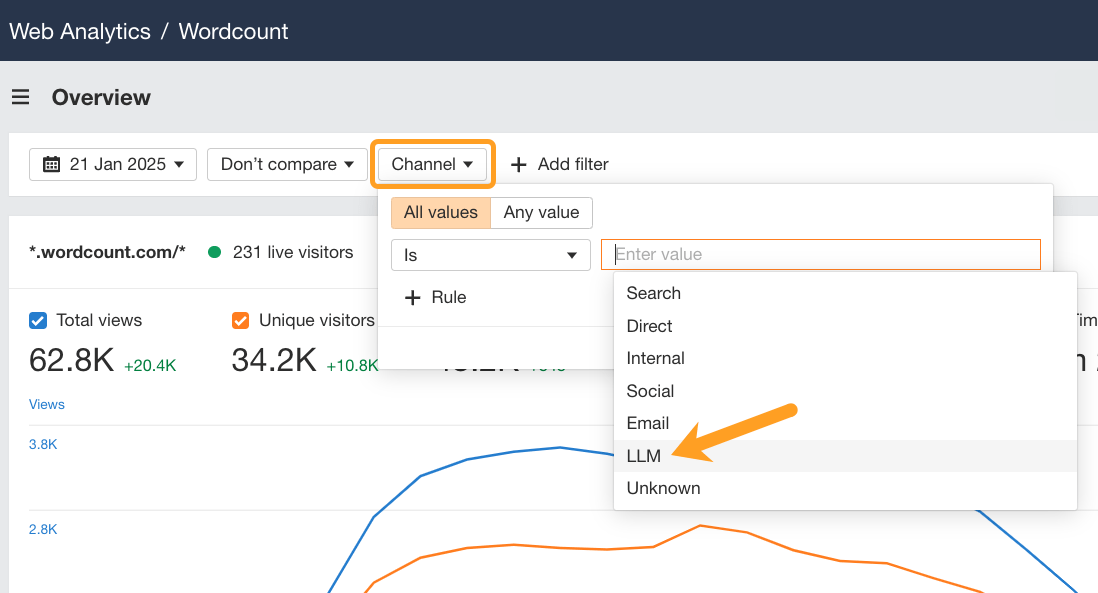
Or a “source” filter to home-in on a specific AI referral source, like ChatGPT…
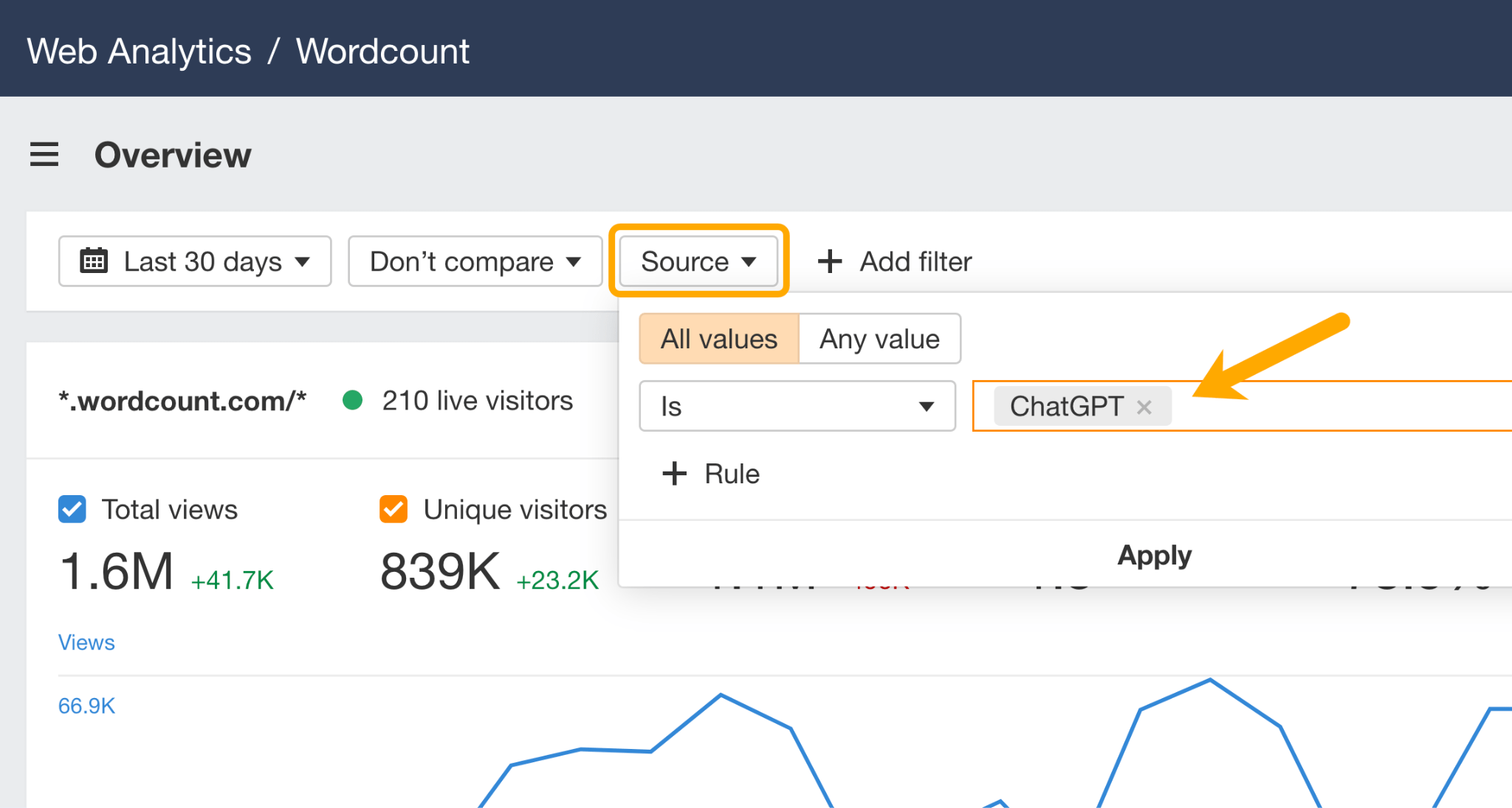
We studied seven of the most popular AI chatbots, and there was a very clear trinity leading the way.
ChatGPT sent over half of all AI traffic, followed by Perplexity which sent just shy of a third, and then Gemini which referred ~18%.
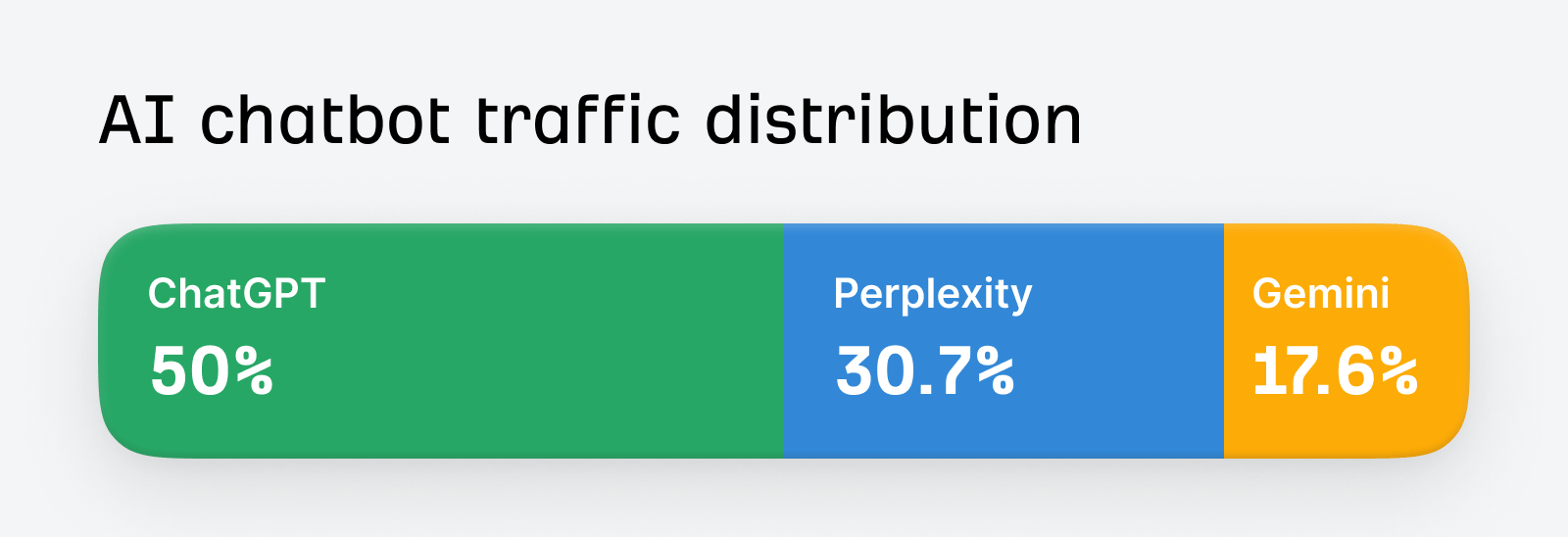
The remaining AI chatbots—Claude, Copilot, Mistral, and Jasper—passed on less than 2% of AI traffic between them.
Copilot’s lack of referral traffic surprised me given that it’s connected to the open web, and has real-time retrieval capabilities—not to mention a market share that exceeds even Gemini or Perplexity.
It’s clear that if you want traffic from AI, you need to focus your attention on the “big three” chatbots driving 98% of AI traffic: ChatGPT, Perplexity, and Gemini.
ChatGPT, in particular, should be your main focus, since it drives half of all AI referrals.
As a percentage of average monthly traffic, 0.12% of a site’s views, and 0.17% of its visitors come from AI.
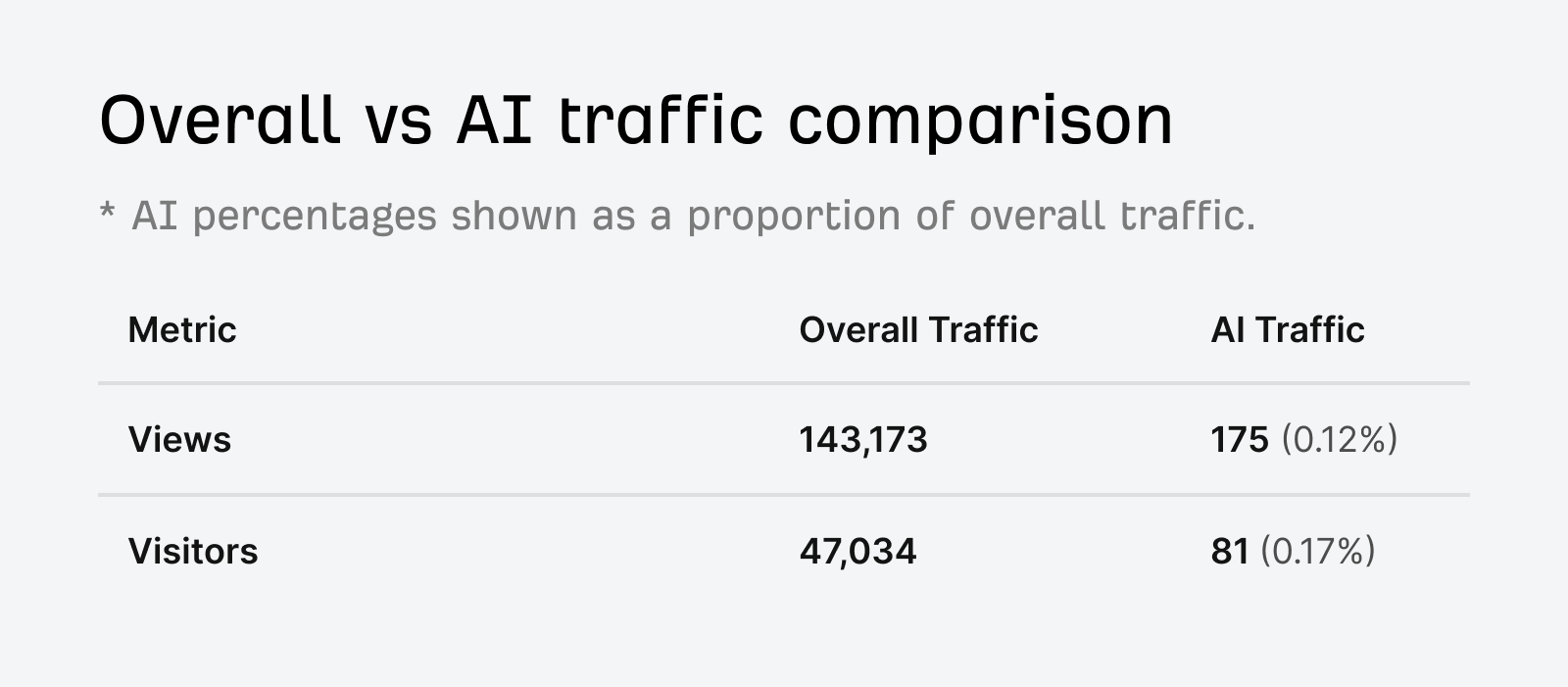
This aligns with what many other marketers are seeing in early-stage LLM traffic studies…
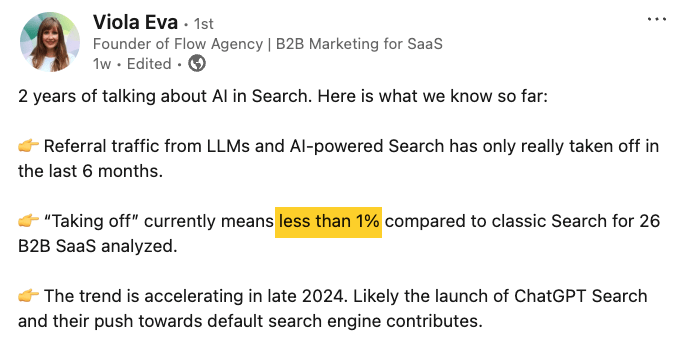
A post from Flow Agency Founder, Viola Eva, showing that less than 1% of traffic came from AI, based on her study of 26 B2B SaaS sites.
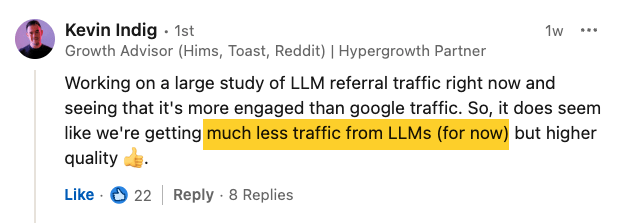
A comment from Kevin Indig on Viola Eva’s post, revealing he is also seeing minimal amounts of traffic from AI/LLMs right now.
Your analytics may show similar or even higher AI traffic numbers.
Across all three cohorts, we noticed the top sites picking up roughly 6% of their total traffic from AI, with one site earning as much as 18%.
While ~0.17% might seem negligible, true figures are likely north of this, since AI visits can get bundled in with “direct” traffic.
With these kinds of reporting quirks, finding other ways to attribute your AI traffic and conversions is a must.
One avenue you can go down is setting up qualitative tracking methods like “How did you hear about us?” forms, to catch what analytics might miss.
For example, we collect qualitative feedback on registration, and to date we’ve seen 14K+ self-attributed new users from ChatGPT.
Now that we’ve analyzed average AI traffic across our entire sample, let’s dig deeper into individual cohorts.
Predictably, the sites earning more visits were also the ones picking up the most AI traffic.
One thing marketers and SEOs have noted about AI tools is that they seem to have a penchant for larger brands…
“AI loves mentioning brand names, regardless of whether a brand is included in the prompt. There are some brands that AI can’t stop talking about. This means that as AI usage grows, some brands will have a big marketing head start. Now is the best/easiest time to become one of these brands because the competition is the sparsest.”
“In the future, large brands are likely to hold substantial advantages in search engine rankings and generative AI outputs due to their superior PR and marketing resources.”
But our data shows that smaller brands (<999 monthly visitors) actually capture more AI traffic as a percentage of their total traffic.
AI optimization isn’t just for the big dogs.
While smaller sites get minimal traffic from AI tools, proportionally, they pick up more of it—meaning they need to pay just as much attention to their AI referrals.
The data also show a difference in the makeup of AI referral sources across the cohorts.
Sites with fewer visits see less diversity—note how ChatGPT sends a greater proportion of AI traffic to smaller websites than it does to larger ones.
It’s wise for any site to focus its AI optimization efforts on ChatGPT, but smaller sites in particular need to pay special attention to this source—not only will it send them the most AI traffic, it’s also one of the few chatbots that sends over visible traffic that’s able to be monitored in analytics tools.
Earlier on, I said I was surprised by Copilot’s lack of AI referral traffic. I mentioned its dominant market share and the fact that it has the ability to cite its sources.
But I was mostly surprised because I know that Copilot has historically sent over high volumes of referral traffic.
Last year, for instance, Ahrefs was receiving a healthy amount of traffic from Copilot—in fact, it was our second-highest AI referrer.
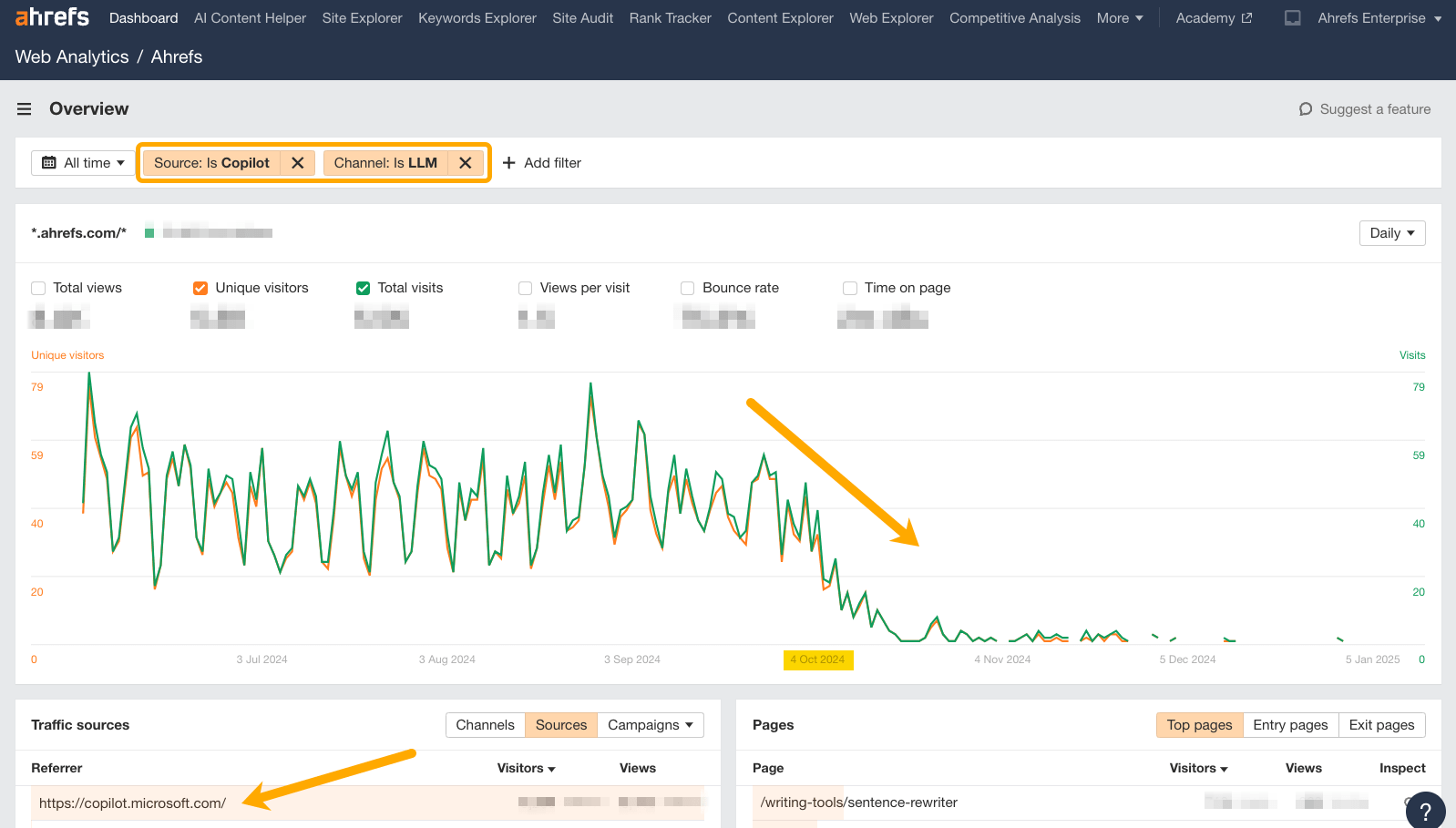
But our traffic from Copilot started to drop off around Q4 2024. And this drop wasn’t unique to us. I validated the same trend in other companies’ analytics instances.
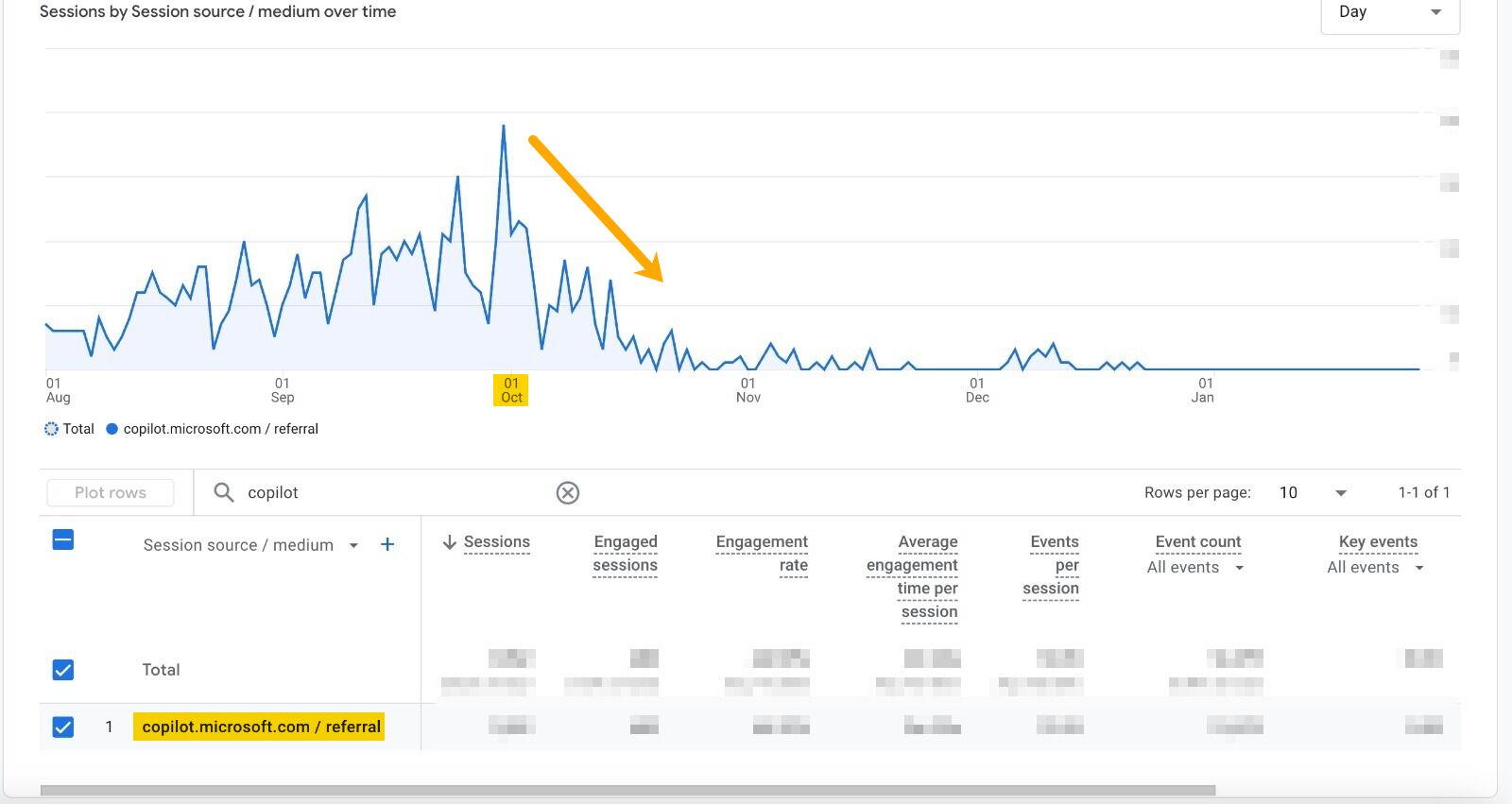
Since roughly October, it’s possible Copilot has been holding back referrer information.
I ran a very small-scale test to find out how Copilot traffic is getting reported in Ahrefs Web Analytics today, as it no longer seems to be coming from the original source:
copilot.microsoft.com.
From the Copilot chatbot, I engineered a prompt that would allow me to navigate to an obscure page on the Ahrefs site—one that hadn’t received any traffic on the day of testing.
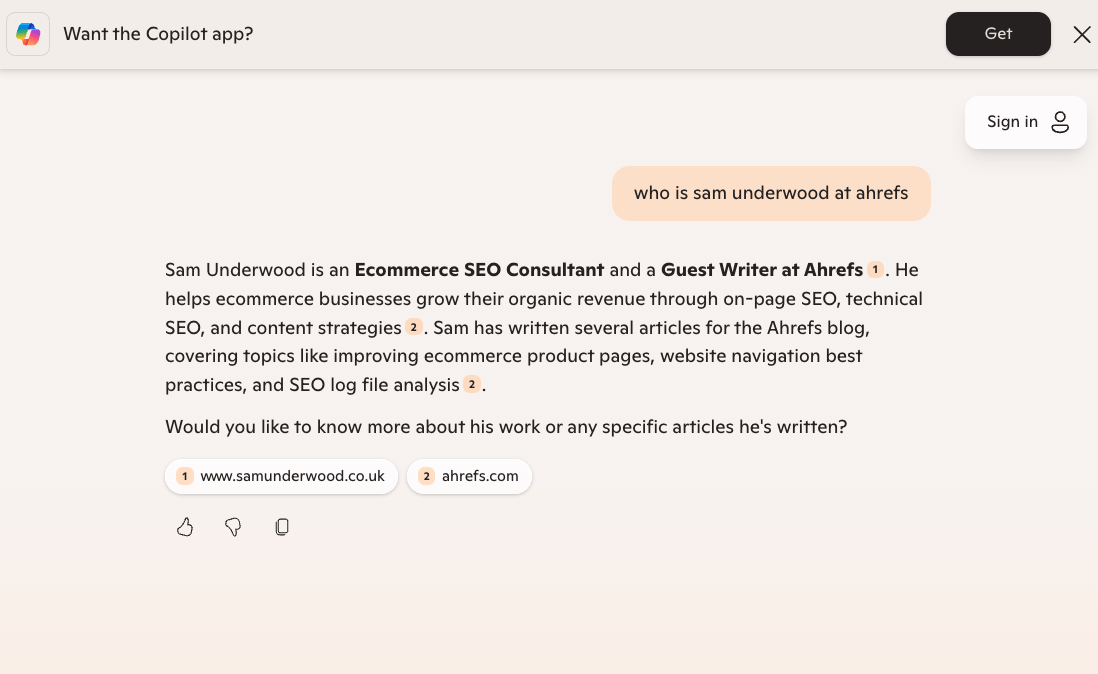
Then I viewed the traffic report in Ahrefs immediately after.
I was able to do this because Ahrefs’ Web Analytics tracks real-time data, meaning I could instantly see website visitors within 1 minute of an event.
The source of the visit showed up as “Direct” (see below).
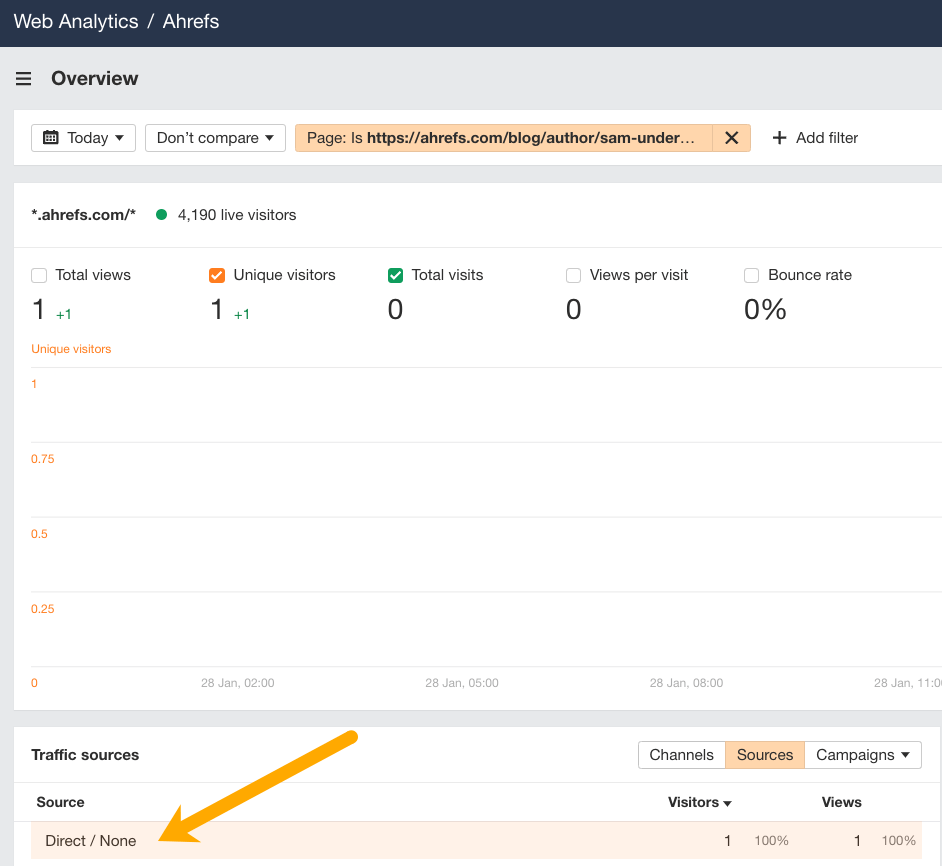
I repeated this same test a few times, and in all cases, the visit registered as “Direct”.
This aligns with what we’d expect to see from websites that don’t pass on referrer information, according to Patrick Stox.
“Websites have control over what info they send. They can send the full path, just the origin, or nothing—it’s up to them. We report whatever referrer we’re told to report. If they don’t send us one, then it would go in the ‘Direct’ bucket.”
Patrick also points out that this might not be a strategic move by Copilot, but rather a mistake.
“Sometimes it’s a mistake. There was a time when the Google app on mobile stripped the referrer, for example.”
I did the same check on Mistral and Jasper, and found that their AI referral traffic also pulls through as “direct”.
The implication of this is AI traffic is likely being vastly underestimated.
And if AI traffic is being underestimated, you can be sure AI conversions are too—particularly since converting users don’t always click through from AI.
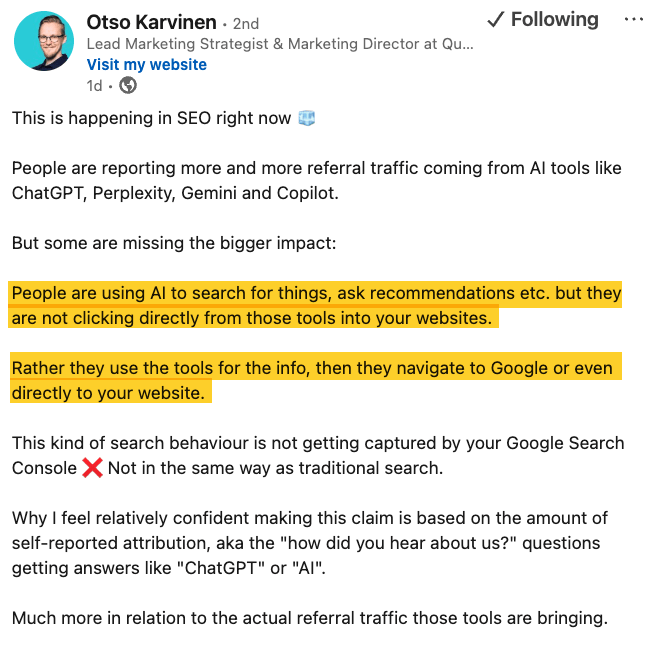
Otso Karvinen asserts that AI users don’t always click directly from AI tools through to websites, and that visits may happen at a later date.
AI tools really come into their own when driving brand awareness. While it’s still possible to convert users from AI, that doesn’t always happen in one neatly packaged conversion journey.
Knowing the limitations in tracking AI traffic and conversions is crucial if you’re setting campaign expectations or reporting results to clients and stakeholders.
Final thoughts
You can use the data in this study to benchmark your own AI traffic and manage expectations.
While you shouldn’t expect tons of AI visits right now, your AI traffic is likely to be greater than your analytics is able to show.
With that in mind, keep an eye on your “direct” traffic. If platforms like Copilot are holding back referrer information, interesting things might be hiding in there.
For instance, pay attention to direct traffic spikes for individual pages—this might just be a sign that untraceable AI sources are referencing that content.
We’ve learnt that larger sites get more traffic from AI—but if your site is small, your AI referrals are going to account for a larger share of your total traffic.
Find and optimize your most-cited content, create more of it, then focus on incremental gains from ChatGPT.
If you found this study interesting, check back on the blog for more AI traffic research.
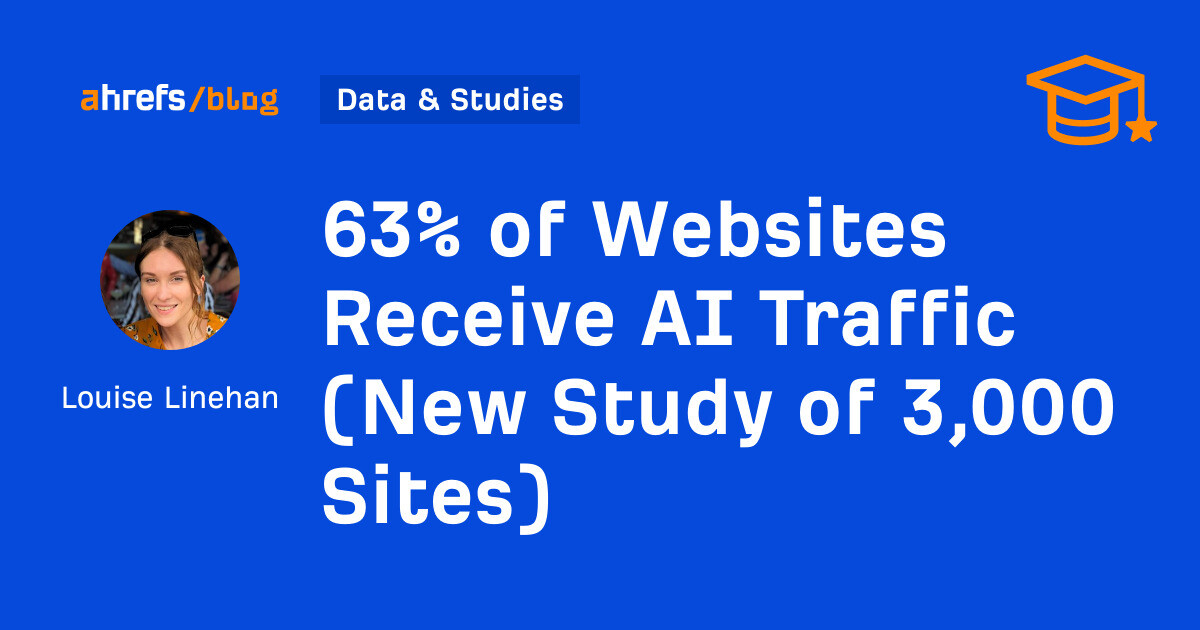
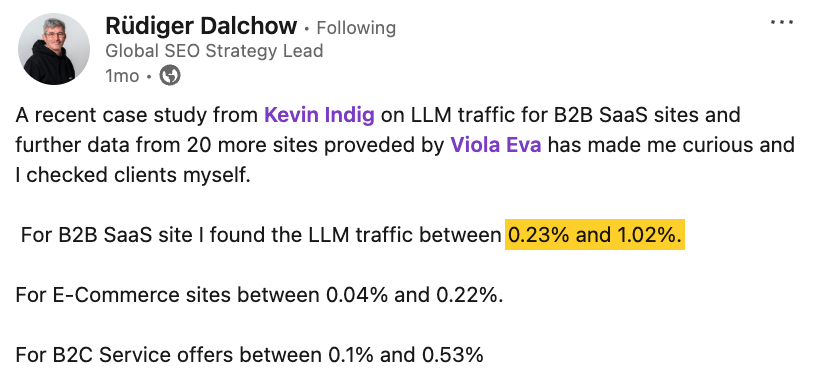
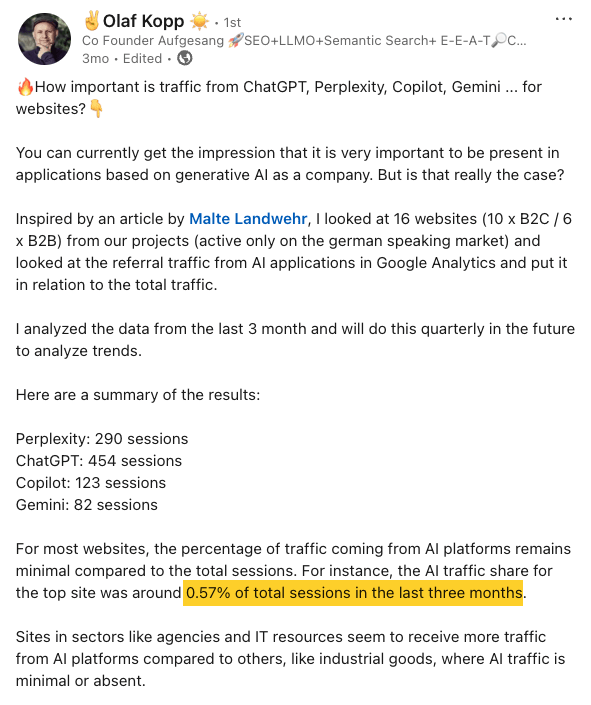
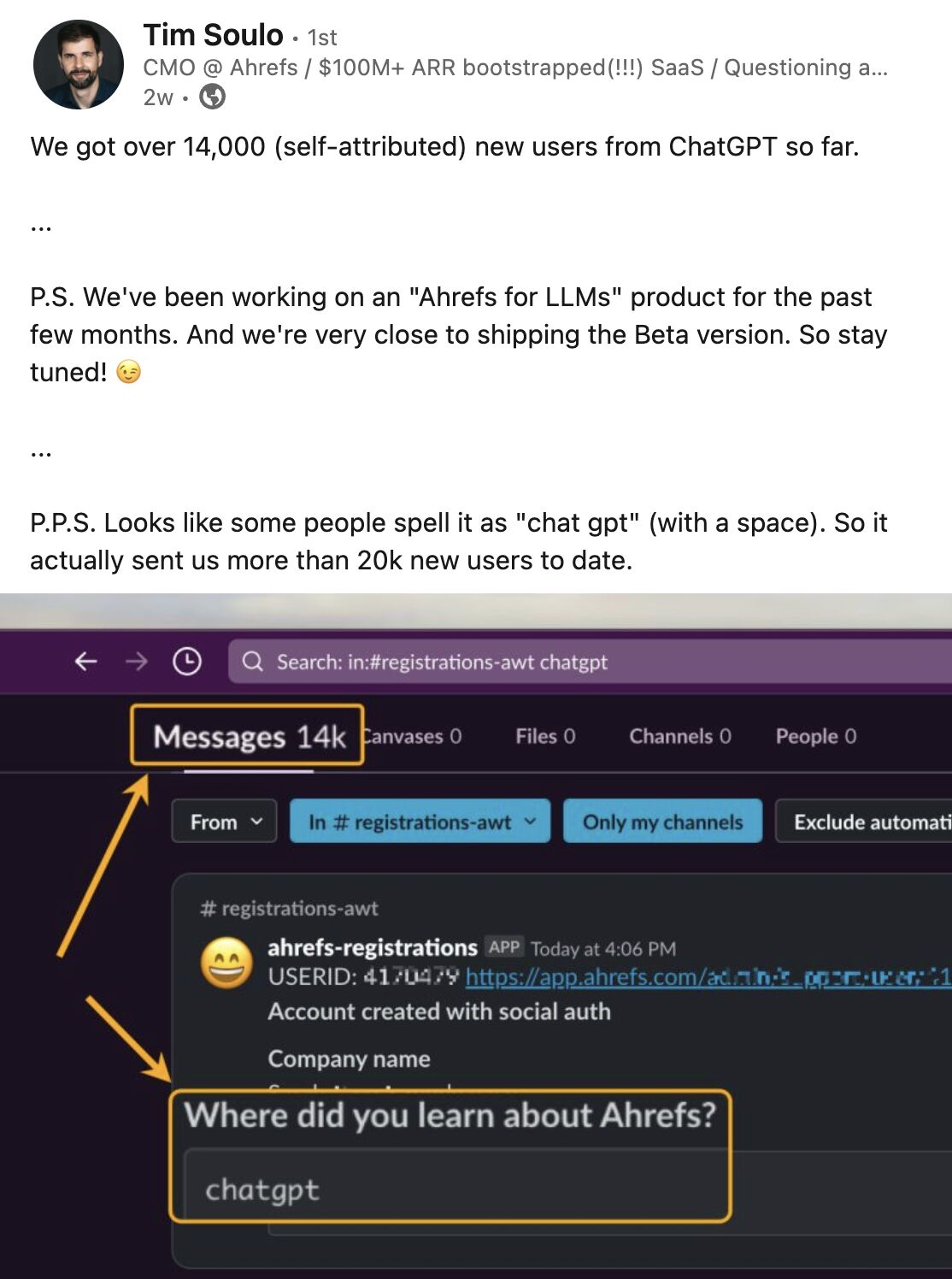

Leave a Reply